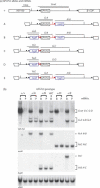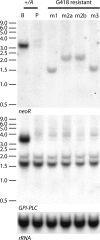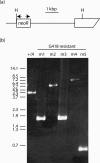A novel strategy to identify the location of necessary and sufficient cis-acting regulatory mRNA elements in trypanosomes
- PMID: 15928343
- PMCID: PMC1360220
- DOI: 10.1261/rna.2510505
A novel strategy to identify the location of necessary and sufficient cis-acting regulatory mRNA elements in trypanosomes
Abstract
Expression of nearly all protein coding genes in trypanosomes is regulated post-transcriptionally, predominantly at the level of mRNA half-life. The identification of cis-acting elements involved in mRNA stability has been hindered by a lack of ability to screen for loss-of-regulation mutants. The method described in this article allows the region containing the necessary and sufficient elements within a mRNA to be identified and uses antibiotic resistance genes as both selectable markers and reporters. In the case of unstable mRNAs, the strategy can be extended by performing a screen for spontaneous loss-of-function mutants in regulatory parts of a mRNA. The method was validated by using the GPI-PLC mRNA, which is unstable in procyclic form trypanosomes and showed that the 3'UTR of the GPI-PLC mRNA contains all elements required for developmentally regulated instability. Loss-of-instability mutants all contained deletions within the 2300-nucleotide-long 3'UTR, and their analysis showed that a deletion including the last 800 nt of the gene stabilized the mRNA. The method is nonpresumptive, allows far more rapid screening for cis-elements than existing procedures, and has the advantage of identifying functional mutants. It is applicable to all eukaryotes using polycistronic transcription.
Figures





Similar articles
-
Developmentally regulated instability of the GPI-PLC mRNA is dependent on a short-lived protein factor.Nucleic Acids Res. 2005 Mar 8;33(5):1503-12. doi: 10.1093/nar/gki298. Print 2005. Nucleic Acids Res. 2005. PMID: 15755751 Free PMC article.
-
Trypanosoma brucei: cis-acting sequences involved in the developmental regulation of PARP expression.Exp Parasitol. 1999 Mar;91(3):222-30. doi: 10.1006/expr.1998.4366. Exp Parasitol. 1999. PMID: 10072324
-
Post-transcriptional control of nuclear-encoded cytochrome oxidase subunits in Trypanosoma brucei: evidence for genome-wide conservation of life-cycle stage-specific regulatory elements.Nucleic Acids Res. 2006;34(18):5312-24. doi: 10.1093/nar/gkl598. Epub 2006 Sep 29. Nucleic Acids Res. 2006. PMID: 17012283 Free PMC article.
-
mRNA splicing in trypanosomes.Int J Med Microbiol. 2012 Oct;302(4-5):221-4. doi: 10.1016/j.ijmm.2012.07.004. Epub 2012 Sep 7. Int J Med Microbiol. 2012. PMID: 22964417 Review.
-
RNA-binding proteins and mRNA turnover in trypanosomes.Trends Parasitol. 2003 Apr;19(4):151-5. doi: 10.1016/s1471-4922(03)00035-7. Trends Parasitol. 2003. PMID: 12689640 Review.
Cited by
-
A high-throughput protein tagging toolkit that retains endogenous untranslated regions for studying gene regulation in kinetoplastids.Open Biol. 2025 Feb;15(2):240334. doi: 10.1098/rsob.240334. Epub 2025 Feb 26. Open Biol. 2025. PMID: 39999874 Free PMC article.
-
Regulation of gene expression in trypanosomatids: living with polycistronic transcription.Open Biol. 2019 Jun 28;9(6):190072. doi: 10.1098/rsob.190072. Epub 2019 Jun 5. Open Biol. 2019. PMID: 31164043 Free PMC article.
-
Post-transcriptional reprogramming by thousands of mRNA untranslated regions in trypanosomes.Nat Commun. 2024 Sep 16;15(1):8113. doi: 10.1038/s41467-024-52432-0. Nat Commun. 2024. PMID: 39285175 Free PMC article.
-
Several different sequences are implicated in bloodstream-form-specific gene expression in Trypanosoma brucei.PLoS Negl Trop Dis. 2022 Mar 21;16(3):e0010030. doi: 10.1371/journal.pntd.0010030. eCollection 2022 Mar. PLoS Negl Trop Dis. 2022. PMID: 35312693 Free PMC article.
-
Codon choice directs constitutive mRNA levels in trypanosomes.Elife. 2018 Mar 15;7:e32467. doi: 10.7554/eLife.32467. Elife. 2018. PMID: 29543152 Free PMC article.
References
-
- Blattner, J. and Clayton, C. 1995. The 3′ untranslated regions from the Trypanosoma brucei phosphoglycerate kinase-encoding genes mediate developmental regulation. Gene 162: 153–156. - PubMed
-
- Brooks, D.R., Denise, H., Westrop, G.D., Coombs, G.H., and Mottram, J.C. 2001. The stage-regulated expression of Leishmania mexicana CPB cysteine proteases is mediated by an intercistronic sequence element. J. Biol. Chem. 276: 47061–47069. - PubMed
-
- Brun, R. and Schönenberger, M. 1979. Cultivation and in vitro cloning of procyclic culture forms of T. brucei in a semi-defined medium. Acta Tropica 36: 289–292. - PubMed
Publication types
MeSH terms
Substances
Grants and funding
LinkOut - more resources
Full Text Sources
Other Literature Sources
Research Materials
